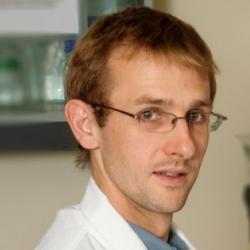Research
My group study the activation and control of the innate immune response. We are focussing on the NOD-like receptor (NLR) family members NOD1 and NOD2, both of which are found in the cytoplasm of cells. NOD1 and NOD2 detect fragments of peptidoglycan from Gram positive and Gram negative bacteria and start a pro-inflammatory immune response. We are particularly interested in the following areas of NOD1 and NOD2 function:
- Receptor activation – we were the first to report directing binding of NOD2 to its ligand. We are now following up this work to identify the precise amino acids involved in ligand recognition.
- Mechanisms of signal transduction – we are investigating the molecular interactions that drive signalling after receptor activation. We are particularly interested in the interfaces involved in interactions between caspase activation domains (CARDs).
- The impact of polymorphisms - single nucleotide polymorphisms in NOD2 are known susceptibility markers for Crohn's Disease. We are assessing the functional and structural impact of polymorphisms in both NOD1 and NOD2.
- NLR evolution - comparative sequence analysis enables us to investigate the conservation of key residues across different species
We employ a range of comparative biology, recombinant protein and functional techniques in our studies and are keen to develop new collaborations.
Publications
Boyle J, Mayle S, Parkhouse R and Monie TP (2013). Comparative genomic and sequence analysis provides insight into the molecular functionality of NOD1 and NOD2. Front. Immunol. 4:317. doi: 10.3389/fimmu.2013.00317
Herre J, Gronlund H, Brookes H, Waggoner L, Gooch S, Murton B, Opaleye N, Fitzgerald K, Gay N, Monie TP*, Bryant C*(2013). Allergens as Immuno-Modulatory Proteins: the cat dander protein FelD1 enhances Toll-like receptor activation by lipid ligands. J Immunol. Aug 15;191(4):1529-35 *Joint corresponding authors.
Joseph P Boyle, Clare E Bryant and Tom P Monie (2013). Cell Swelling and the NLRP3 Inflammasome. Immunity. Mar 21;38(3):399.
Monie TP. (2013) NLR activation takes a direct route. Trends Biochem Sci. 2013 Mar;38(3):131-9
Mo J-Y, Boyle JP, Howard CB, Monie TP, Davis BK, Duncan JA. (2012) NOD2 mediated pathogen sensing is mediated by direct binding to muramyl dipeptide and ATP. J Biol Chem. 2012 Jun 29;287(27):23057-67
Boyle JP and Monie TP. (2012) Computational Analysis Predicts the Kaposi’s Sarcoma-Associated Herpesvirus Tegument Protein ORF63 to be Alpha Helical. Proteins. 2012 Aug;80(8):2063-70



